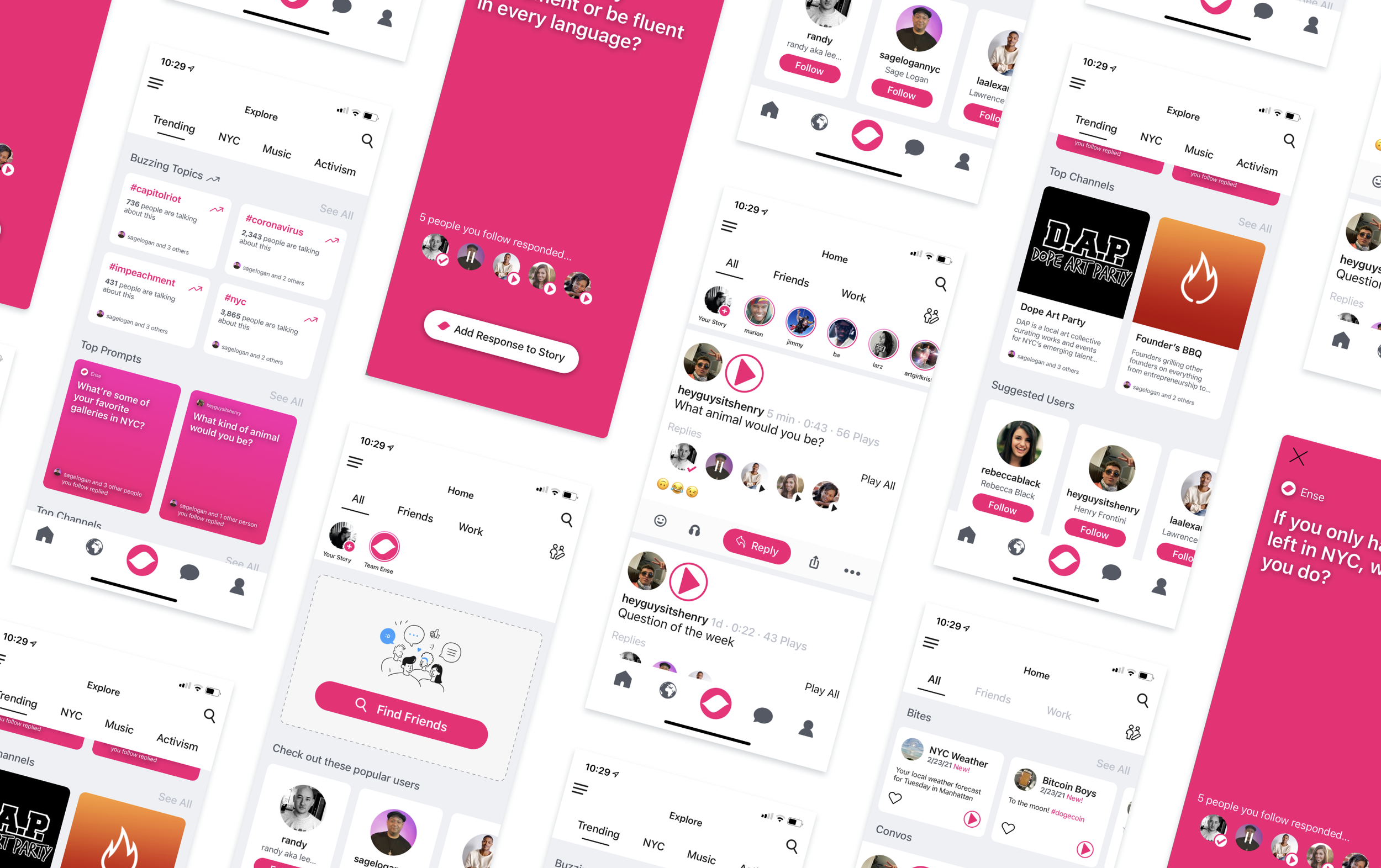
Ense
Revamping a voice-based social media app
Pitched a new direction to the founder, joined full-time, refined the strategy, redesigned the UX/UI, and increased engagement by 260%.
Overview
I joined Ense, a pioneering voice-based social media platform founded by Iqram Magdon-Ismail, co-founder of Venmo. Before Clubhouse, Ense was already exploring the potential of voice as a social medium with a unique asynchronous approach. While the mission to foster conversations and promote inclusivity was noble, the user experience needed significant refinement to succeed.
I spent my first few weeks doing an analysis. In between user interviews, I kept one eye busy with dogfooding and the other on the dashboard. Eventually, I synthesized some insights and recommendations into a proposal deck for the founder. He bought in and we went right to work.
That deck is here…
The below details my approach through the analysis and my first few months refining the strategy and roadmap.
Understanding the market
The rise of podcasts and audiobooks signaled a growing interest in audible media. Yet, traditional social media had evolved into a predominantly silent experience, relying heavily on visual and textual interactions. Integrating voice into these contexts presented challenges, as it required users to adapt to speaking into their devices as comfortably as they typed. This was a significant cultural shift, especially considering the common fear of public speaking (glossophobia).
Understanding the nuances of voice communication demanded a deep appreciation for cultural, psychological, and behavioral factors. It was crucial to identify suitable contexts for voice interaction, balance the needs of creators and listeners, and develop a user-centric product strategy.
Challenges identified
Normative cultural behaviors favored eyes and text (not voice)
Identifying and capturing appropriate contexts for voice interaction
Balancing the needs of creators and listeners
Method
User Interviews
Conducted in-depth interviews with ~20 users to gather qualitative insights into their experiences, behaviors, and pain points with the app. These interviews helped us understand the cultural and psychological factors influencing user engagement with voice-based interactions.
Surveys
Distributed surveys to approximately 50 users to collect quantitative data on their usage patterns, preferences, and reasons for churn. Analyzed survey responses to identify common trends and issues.
Dashboard Analysis
Examined user engagement metrics and first-time user behavior from the app’s dashboard. This analysis revealed that a significant portion of churn occurred after users listened to fewer than two Enses.
Competitor Analysis
Studied other voice-based and traditional social media platforms to identify best practices and areas for improvement. This included examining UI/UX design, user engagement strategies, and onboarding processes.
Defining the E2E experience as I found it
After interviewing ~20 users (of varying engagement with the product), I had garnered the essential insights to define the foundations of the experience and highlight the gaps.
With some reasons to churn defined, I needed to know where and how users were activating
After looking at survey responses from ~50 users and looking at the dashboard, it became apparent that first impressions were killing us. The majority of churn was coming from first-time users who only listened to an average of <2 Enses and never came back.
The problem space was comprised of 6 themes
Creating themes for these opportunity areas would set us up for…
A better relational understanding of the problems
A broad and organized approach at decreasing churn
A packaged and more strategic delivery of value.
Mapping the opportunities made prioritization intuitive
Evaluating the product gaps adjacent in the user experience/journey, it became obvious where we would (and wouldn’t) be interested in placing bets/directing our attention.
Key questions
How might we improve the first time experience/TTV?
How might we facilitate social connections for new users?
How might we facilitate discovery of desired content during session 1?
How might we define activated users?
Assumptions of an improved experience spanned across creation and consumption
With the gaps identified, we started filling. Most importantly, we defined an aha moment, and changed our north star from a listener-based metric to a creator-based metric. My position being that more creators wasn’t only more leading—thus more actionable—but would ultimately result in more listeners.
Our prioritized solutions informed new goals and a new roadmap
Hypothesis: By way of some thorough housekeeping (i.e., removing the evident UX impediments), hosting a diversity of content, and simplifying feed curation during onboarding, we would drive engagement and improve retention.
I redefined what was considered an “activated” user and redesigned the product’s ability to cultivate them.
“Activated users” were split into 3 forms:
Activated listeners: Listen to 3 different forms of content
Activated creators: Send 3 Enses
Fully activated: Combination of the above 2
In order to drive up this kind of activation, onboarding needed a complete overhaul. I designed an alternative first-time experience indexing on feed curation and discovering friends. The underlying principle was simple: the more relevant the content, the more resonant.






